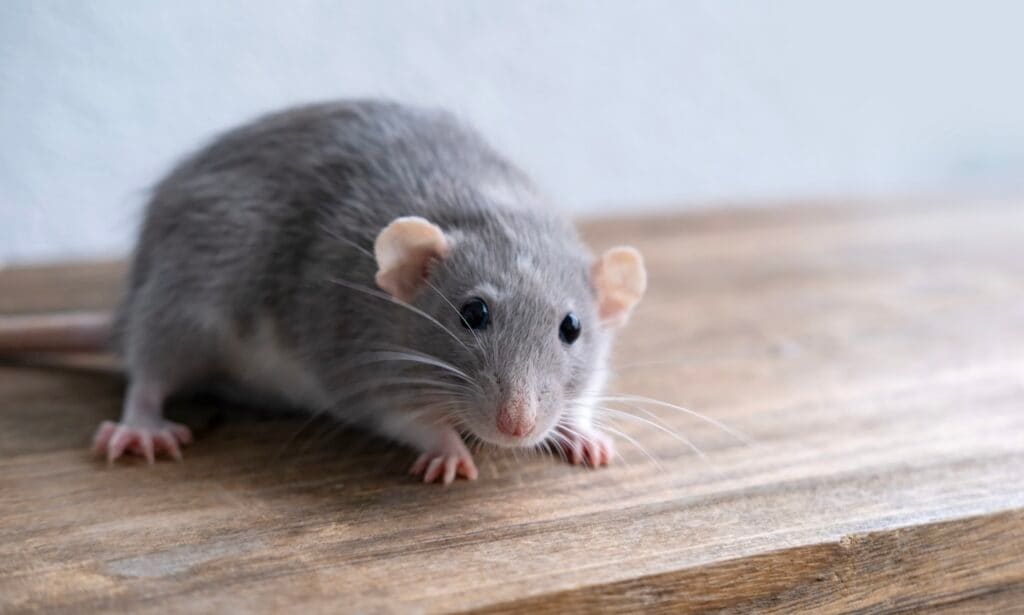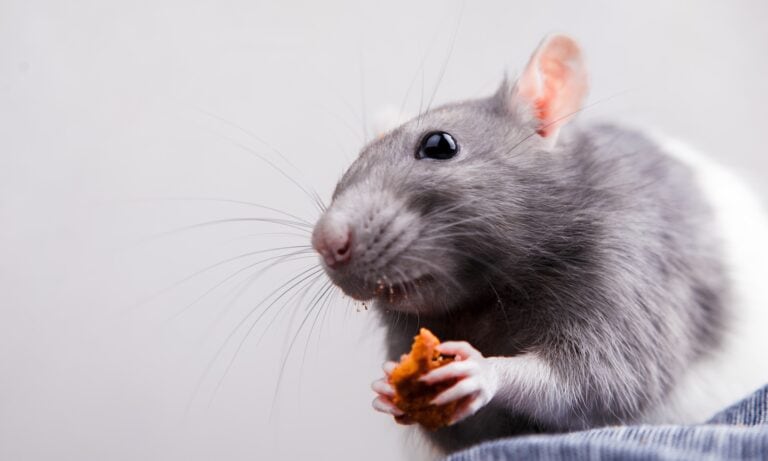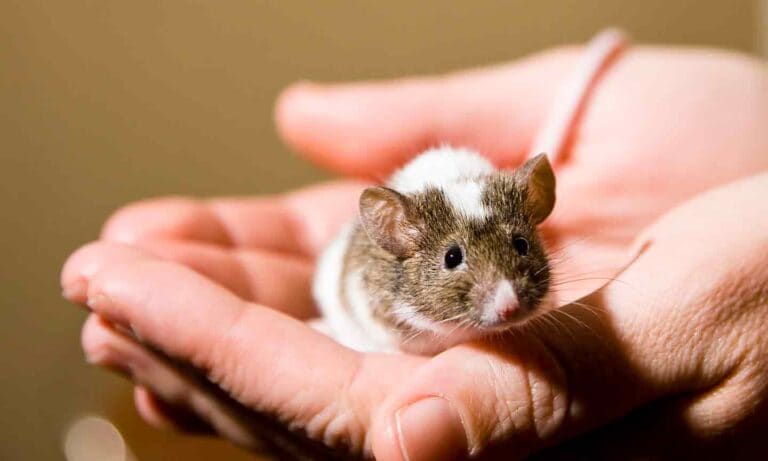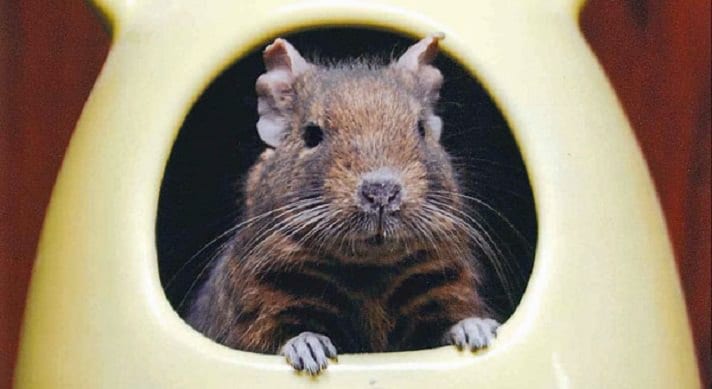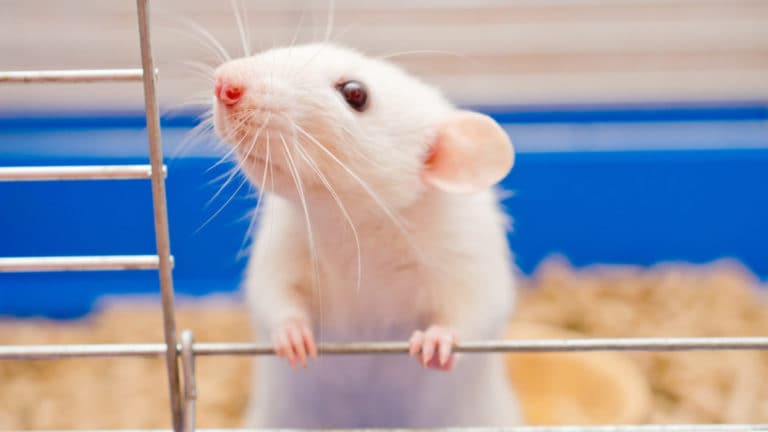Thinking about adopting a pet rat?
These intelligent animals, often misunderstood as pests, are surprisingly affectionate companions. They love cuddles, rarely bite, and enjoy gentle scratches behind the ear, making them a popular pet for families with children.
But before you bring one home, it’s worth asking how big rats get—and how much space they’ll need in their habitat.
The size of your future pet rat can vary slightly by rat type, but mostly by sex and body condition, says Dr. Marcie Logsdon, an associate professor of exotics and wildlife at Washington State University's College of Veterinary Medicine in Pullman, Washington.
Let’s explore common pet rat varieties, typical sizes, and factors that can change a rat’s adult size.
In This Guide:
Types of Rats and Their Sizes
While pet rats might look very different, they’re all part of the same rat species, Rattus norvegicus. They’re kind of like dogs—one species but many types, Dr. Logsdon explains. In fact, rats come in more than 40 fur colors and with black, ruby, red, or pink eye colors.
According to the American Fancy Rat and Mouse Association (AFRMA), seven distinct varieties of rats are recognized for show:
1. Standard Fancy Rat
You could think of the standard fancy rat as the foundation for all pet rat types. Each pet rat variety is the result of a tweak or genetic mutation in the standard fancy rat.
They come in all colors and patterns, such as hooded, white, and cinnamon. The standard fancy rat typically weighs 0.7–1.4 pounds and measures 16–20 inches from head to tail.
2. Tailless
As their name suggests, tailless rats are born without tails. They come in any color and pattern like the standard fancy rat but are about half the size—around 8 to 10 inches long and weighing less than 1.4 pounds. Their bodies tend to be stockier than the standard fancy rat, and they tend to have a rounder rump, according to AFRMA.
3. Rex
Rex is the name given to animals with a curly or wavy coat, and the rex rat follows this pattern.
They have dense fur with curls ranging from tight ringlets to a loose wave, although by 18 months the coat thins, and the rex rat may even become partially bald. The belly typically has a slightly looser wave than the body. Even their whiskers have a charming kink or curl. They weigh 0.7–1.4 pounds and measure 16–20 inches from head to tail.
4. Hairless
Rather than losing fur with age, hairless rats are born completely fur-free.
Their wrinkled skin comes in all the same colors and patterns seen in the standard fancy rat. While some hairless rats lack whiskers entirely, others have short or curly ones. The hairless rat typically weighs 0.7–1.4 pounds and measures 16–20 inches from head to tail.
5. Satin
You’ll recognize a satin rat by their shiny coat that might seem to sparkle, which is what they’re named after. In addition to a healthy sheen, the rat’s coat will be a little longer than other rat types but thin and soft to the touch.
Their whiskers may be kinked or curled. Satin rats typically weigh 0.7–1.4 pounds and measure 16–20 inches from head to tail. They may be more slender than other rat varieties.
6. Dumbo
Dumbo rats get their name from their special ears. Set lower on the head than standard fancy rats, their ears are large and round, creating a resemblance to Disney's lovable elephant.
But how big do dumbo rats get? Around the same size or perhaps slightly larger than other pet rat varieties—about 1.5 pounds and 15 to 22 inches from head to tail.
7. Bristle Coat
Petting a bristle coat fancy rat is like touching a warm wire brush. Their fur has a specific coarse texture, like a Wirehaired Pointing Griffon dog.
Young bristle rats might have a slight wave to their fur, but it matures into a straighter, sometimes unkempt-looking coat in adulthood. Like other fancy rat varieties, they typically weigh 0.7 to 1.4 pounds and measure 16–20 inches from head to tail.
What Influences the Size of a Rat?
Most fancy rat breeds share a similar size range (0.7 to 1.4 pounds and 16 to 20 inches from head to tail), with the tailless rat being the exception due to the lack of tail.
Dr. Logsdon explains that the variation in fancy rat sizes is due to two main factors (in addition to the parent rats’ genetics).
Sex
Male rats tend to be larger and heavier than females. The typical male rat weighs 0.9 to 1.4 pounds, and the typical female weighs 0.7–0.9 pounds.
If you’re not sure what sex your rat is, read about how to tell the difference between male and female rats.
Body Condition
Rats can become overweight. This is especially true if they live with other rats, since watching how much each rat eats can be tricky.
Dr. Logsdon says their sweet tooth for treats like fruits can also lead to weight gain. A seemingly large rat might simply be carrying extra weight. Dr. Logsdon offers a few helpful tips to check.
Healthy rats should:
- Taper at the neck just a bit
- Have a slight waist
- Have bellies that don’t drag on the ground
How Big Should Your Rat’s Habitat Be?
“Regardless of rat body size, a minimum enclosure for rats should be 3 feet by 3 feet by 3 feet for one to three rats,” says exotic companion veterinarian Sandra Mitchell, DVM, DABVP, owner of All Creatures Veterinary Services in Eddington, Maine.
Dr. Logsdon agrees, adding that even young rats can start in larger enclosures if the bar spacing is small enough to prevent escapes.
Rats are natural climbers, so providing tall or multi-level habitats can keep them entertained and well-exercised.
Here are two examples of good habitats:
Caring for Your Rat
Dr. Mitchell and Dr. Logsdon offer the following tips to help care for your pet rat:
- Find an exotic animal veterinarian soon after getting your pet rat. Dr. Mitchell recommends a checkup when bringing your new rat home and then two to four times a year after that.
- Limit sugary treats (fruits and veggies) and give set portions to avoid obesity. Mazuri® Rat and Mouse Diet is a popular rodent block option, which is a complete and balanced meal for rats.
- Give your rat an enclosure that has plenty of space for playtime. Offer toys made from safe materials like wood or sisal for mental stimulation and physical activity. Because rat teeth never stop growing, having wooden chew toys, such as these hanging chew blocks from Vila, is important for rat dental health.
- Make sure the enclosure has lots of ventilation but bars small enough to prevent escapes. Give plenty of bedding, such as Carefresh® natural bedding, for burrowing in and keeping the enclosure clean.
- Consider spaying or neutering your rats. This can extend the life expectancy of female rats by significantly reducing the risk of cancer, Dr. Logsdon says. Plus, it can help multiple rats get along better and prevent unwanted litters.
- When thinking about getting more than one pet rat, Dr. Logsdon recommends getting them from the same place around the same time. This lowers the risk of spreading illnesses.
Whether you're drawn to the large ears of Dumbo rats or the curly coats of Rex rats, knowing how big they get will help you care for your pet.
Expert input provided by Marcie Logsdon, DVM, a veterinarian at Washington State University’s Veterinary Teaching Hospital in Pullman, Washington and Sandra Mitchell, DVM, DABVP, owner of All Creatures Veterinary Services in Eddington, Maine.
Like this story? Check out more of our favorite reads:
Share:
